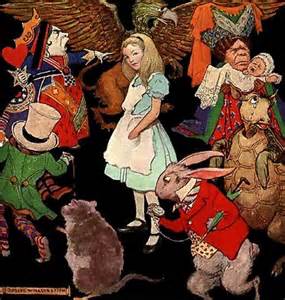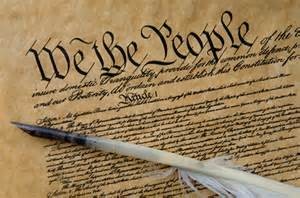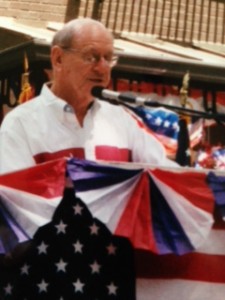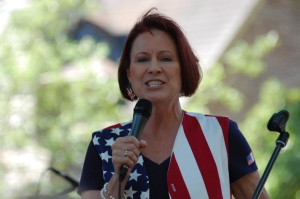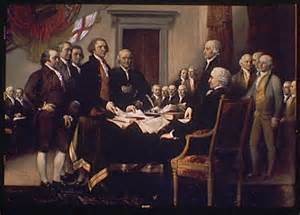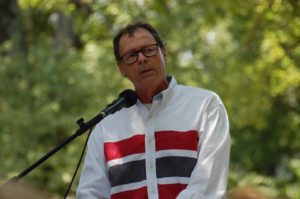Curiouser and Curiouser
A couple of years ago Kay and I took our kids and grandkids and my mother and uncle on a family vacation in north Georgia. We rented a house with lots a space inside and an expansive yard, more like grounds. Other family members came and went during the week. The best feature was a front porch the width of the house with enough rocking chairs to accommodate most everyone. Evening meals were communal affairs and the table conversation lasted well beyond the bedtimes of grandkids. The reluctance to get up from the table was not for dread of cleaning the aftermath of a delicious meal but bringing a premature end to the stimulating and often raucous conversation that would make my mother blush just before she gave in to a grand cackle.
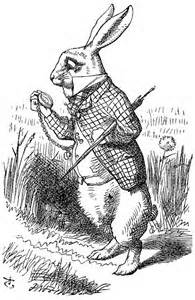 It was during one such meal, in the middle of one such conversation that Kay blurted out, “I saw a white rabbit today.” Now imagine the sound effect of screeching tires on a vehicle as it comes to an abrupt stop as did our table conversation. All eyes came into unified focus directed toward Kay like the spotlight she hates. She had been out for a walk that day and claimed to have seen a white rabbit scampering across the grounds and disappear in the dense brush; admittedly, an unusual sight. Something in the table talk had triggered the memory of that experience, or Kay had disassociated from the conversation indulging in the private pleasure of seeing a white rabbit once again in her mind. We all began to laugh at the joy of so spontaneous a thought, and Kay had to endure some good-natured kidding from her family.
It was during one such meal, in the middle of one such conversation that Kay blurted out, “I saw a white rabbit today.” Now imagine the sound effect of screeching tires on a vehicle as it comes to an abrupt stop as did our table conversation. All eyes came into unified focus directed toward Kay like the spotlight she hates. She had been out for a walk that day and claimed to have seen a white rabbit scampering across the grounds and disappear in the dense brush; admittedly, an unusual sight. Something in the table talk had triggered the memory of that experience, or Kay had disassociated from the conversation indulging in the private pleasure of seeing a white rabbit once again in her mind. We all began to laugh at the joy of so spontaneous a thought, and Kay had to endure some good-natured kidding from her family.
“Kaymi, where rabbit?” John Erik asked, his eyes big as Mad Hatter tea saucers. Our two-year-old grandson at the time was the only one who ventured true belief. Everyone deserves to see a white rabbit whether others believe or not.
“’Curiouser and curiouser!’” cried Alice…she was so much surprised, that for the moment she quite forgot how to 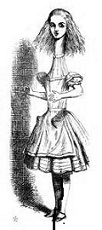 speak good English.” That was a quote from “Alice’s Adventures in Wonderland” as she remarks on the effect of eating some cake that caused her neck to “open out like the largest telescope that ever was.”
speak good English.” That was a quote from “Alice’s Adventures in Wonderland” as she remarks on the effect of eating some cake that caused her neck to “open out like the largest telescope that ever was.”
Everyone knows the common and versatile definition of the word “curious:” being inquisitive; prying; showing keen interest; defining something as odd or strange. But the archaic Latin meaning has more depth: “something made or prepared with skill, something done with painstaking accuracy, with obvious signs of paying attention to detail and marked by intricacy.” Over the years I’ve watched Kay go to work on a creative project, and whatever she sets her mind to, be it painting watercolors, making Santa’s, precision cutting crown-molding with a saw, flower arrangement, or hand-carving a bird house or blocks, she epitomizes the deeper meaning of the state of being “curious.” And by being in such a state of curiosity, the work she produces has a quality that goes beyond mere craft and touches the hem of art.
We all have some degree of talent in some area, but it will not take one far unless the spark of curiosity ignites the imagination. The standard practice of most educational systems is to teach to the test. So the kid in class who gets distracted by the “white rabbit” scampering past the window is too quickly diagnosed with some disorder, medicated, and instructed to get in line. The imagination which could open a child to multiple possibilities of discovery is too often forced to take a backseat to standardized thinking, which when children become adults, too often becomes corporate thinking.
Alice was curious about the white rabbit and followed it. She was engaged, and when she came to the cake with the sign that said, “Eat me,” she did so. She had no idea what she would discover by chasing a white rabbit or consuming a magical cake. The formula was simple: being curious fired the imagination which afforded discovery. Think of all the discoveries Alice made about herself, her family, her society by following that white rabbit down the rabbit hole. In other words, when the white rabbit appears in the imagination anything can happen. The act of creating is an act of bravery. Something is always at stake to the creator because they may lose something and never recover. That is the nature of creation. But there could be so much more to gain when one takes that risk: learning secrets, learning lessons, learning harmony in daily life.
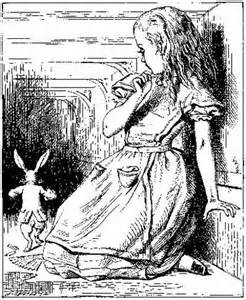 The morning we left from our vacation, Kay was driving the lead car in our four-car caravan down the driveway. I was driving the second car and saw the brake lights come on well before we were to exit the compound. Kay leapt out of the car and pointed across the street to the white rabbit in an adjacent yard sitting beside a tree munching on some tasty, verdant morsel. And so in the end, all of us agnostics had to admit the existence of “white rabbit,” and Kay took a well-deserved bow before getting back into her car. Vindication was sweet, and the joke was on us.
The morning we left from our vacation, Kay was driving the lead car in our four-car caravan down the driveway. I was driving the second car and saw the brake lights come on well before we were to exit the compound. Kay leapt out of the car and pointed across the street to the white rabbit in an adjacent yard sitting beside a tree munching on some tasty, verdant morsel. And so in the end, all of us agnostics had to admit the existence of “white rabbit,” and Kay took a well-deserved bow before getting back into her car. Vindication was sweet, and the joke was on us.
Lewis Carroll wrote his story about children, for children. He started the story with Alice being very bored and in her boredom she discovered the white rabbit. I wonder if children today don’t have time to get bored. Perhaps if they were allowed that freedom, more white rabbits would come along and beckon them to follow. Alice and Kay saw the white rabbit and followed. When the opportunity for a white rabbit crosses your path, be curious enough to follow.

